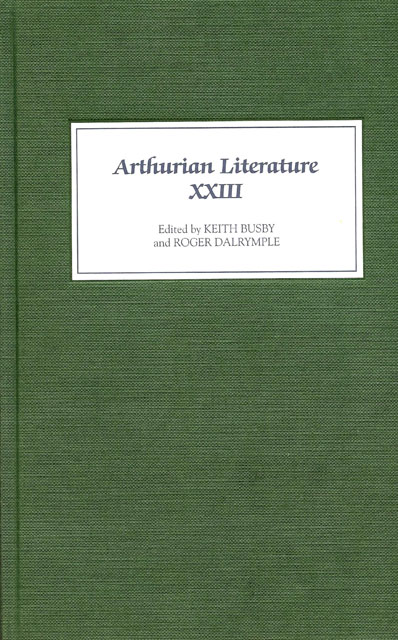Book contents
- Frontmatter
- Contents
- General Editor’s Foreword
- I Beyond Shame: Chivalric Cowardice and Arthurian Narrative
- II Malory’s Forty Knights
- III Fooling with Language: Sir Dinadan in Malory’s Morte Darthur
- IV William Caxton, Wynkyn de Worde and the Editing of Malory’s Morte Darthur
- V Ballad and Popular Romance in the Percy Folio
- VI Local Hero: Gawain and the Politics of Arthurianism
- VII Promise-postponement Device in The Awntyrs Off Arthure: a Possible Narrative Model
- VIII L’Atre perilleux and the Erasure of Identity
- IX The Theme of the Handsome Coward in the Post-Vulgate Queste del Saint Graal
- X A Time of Gifts? Jean de Nesle, William A. Nitze and The Perlesvaus
- XI Thomas Love Peacock’s The Misfortunes of Elphin and the Romantic Arthur
- Contents of Previous Volumes
General Editor’s Foreword
Published online by Cambridge University Press: 23 March 2023
- Frontmatter
- Contents
- General Editor’s Foreword
- I Beyond Shame: Chivalric Cowardice and Arthurian Narrative
- II Malory’s Forty Knights
- III Fooling with Language: Sir Dinadan in Malory’s Morte Darthur
- IV William Caxton, Wynkyn de Worde and the Editing of Malory’s Morte Darthur
- V Ballad and Popular Romance in the Percy Folio
- VI Local Hero: Gawain and the Politics of Arthurianism
- VII Promise-postponement Device in The Awntyrs Off Arthure: a Possible Narrative Model
- VIII L’Atre perilleux and the Erasure of Identity
- IX The Theme of the Handsome Coward in the Post-Vulgate Queste del Saint Graal
- X A Time of Gifts? Jean de Nesle, William A. Nitze and The Perlesvaus
- XI Thomas Love Peacock’s The Misfortunes of Elphin and the Romantic Arthur
- Contents of Previous Volumes
Summary
Vol. XXIII of Arthurian Literature contains a wide-ranging selection of articles dealing with texts from the classical and ‘post-classical’ periods of French romance through Malory's Arthuriad to Thomas Love Peacock. Andrew Lynch's amply-documented study of cowardice and Arthurian narrative reveals a subtle and shifting treatment of the theme in works from the twelfth through the fifteenth century. No-one knows the history and sources of Malory's Morte Darthur better than Peter Field, whose careful examination of the forty knights in Caxton and the Winchester manuscript demonstrates both the potential and limitations of textual criticism. The extraordinary character of Sir Dinadan in Malory is revealed through Joyce Coleman's persuasive analysis of the language acts in which he takes part. D. Thomas Hanks Jr compares the various states of Malory's text from the Winchester manuscript through Wynkyn de Worde, arguing that modern editions can both facilitate and hinder our appreciation of the author's style. The relationship between popular romance and the ballad is considered by Raluca Radulescu, who argues that a detailed comparison of the two would help reveal their significance for their primary audiences. Margaret Robson shows exactly how pervasive the Arthurian tradition was in a political sense, demonstrating its meaning for the rebellion of Owain Glyn Dwr, and drawing parallels with some of the later English Gawain romances. The Awntyrs Off Arthure is also the subject of Martin Connolly's contribution, in which he reveals that the sequence of spiritual promise and worldly postponement is one of the basic narrative structures of the poem. Norris J. Lacy approaches L’Atre périlleux through its author's complex and varied exploration of notions of identity, while Fanni Bogdanow re-opens the dossier of the Handsome Coward with particular reference to the Post-Vulgate Queste del Saint Graal. Tony Grand looks at the Perlesvaus, still one of the great unexplored prose romances, reviewing the thorny presentation issue in the light of Jean de Nesle's biography. Finally, Robert Gossedge's article on Thomas Love Peacock's The Misfortunes of Elphin shows how this pre-Tennysonian work serves as a sympathetic showpiece for the author's knowledge of Welsh tradition.
Keith Busby
Madison, Wisconsin
- Type
- Chapter
- Information
- Arthurian Literature XXIII , pp. vii - viiiPublisher: Boydell & BrewerPrint publication year: 2006

